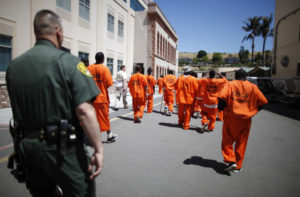Fifty years ago, the late-Senator Daniel Patrick Moynihan’s report, “The Negro Family,” helped pave the way for America’s mass incarceration boom, resulting in a nation with the world’s largest prison population and the largest rate of imprisonment.
The U.S. has under 5 percent of the world’s population, but holds 25 percent of the world’s prisoners behind bars. The key to that system of mass incarceration were policies that criminalized Black men. And the criminalization of Black men is something this nation has had centuries to develop, perfect and implement.
As Ta-Nehisi Coates writes in his essay, “The Black Family in the Age of Mass Incarceration” for The Atlantic, Moynihan, a liberal who was “the product of a broken home and a pathological family,” had good intentions when he wrote his report, “The Negro Family: The Case for National Action” half a century ago. The report argued that the government underestimated the damage brought upon Black families by “three centuries of sometimes unimaginable mistreatment” and a “racist virus in the American blood stream,” continuing to plague Blacks in the future:
That the Negro American has survived at all is extraordinary—a lesser people might simply have died out, as indeed others have … But it may not be supposed that the Negro American community has not paid a fearful price for the incredible mistreatment to which it has been subjected over the past three centuries.
Moynihan pointed to a Black family structure altered by white supremacy. He believed a matriarchal structure deformed the Black community and robbed Black men of their birthright, and pointed to problems such as high Black-male unemployment, high out-of-wedlock births and welfare dependency.
Although Moynihan had a number of ideas regarding what should be done to address the crisis of Black men, such as a government jobs program and a guaranteed minimum income, integrating the suburbs, access to birth control and increasing the number of Black men in the military, none of these recommendations made their way into “The Negro Family.” The paper was not meant to be published, and the author has been attacked for racism, for seeming to place the blame of the Black family’s problems on Black women, and for seeking to improve the situation of African-American men at the expense of women.
Further, given Moynihan’s own lack of solutions in his report–which seemed to point to white culpability and the need for white action—as well as his own drift towards “blaming the victim,” policy makers and lawmakers used the report to engage in the criminalization of Black men. The result was a completely fabricated “tough on crime” stance under the Nixon administration, which linked Martin Luther King’s civil disobedience to rising crime. This led to the war on drugs, and a bipartisan effort by liberal Democrats and conservative Republicans to address the “three centuries of sometimes unimaginable mistreatment” Moynihan identified regarding African-Americans.
The bipartisan solution was not through education or social service programs, but rather mass incarceration, as well as a “carceral state” that banishes Americans from society even after one has completed a prison sentence.
“At a cost of $80 billion a year, American correctional facilities are a social-service program—providing health care, meals, and shelter for a whole class of people,” Coates wrote.
As a result of the prison boom, which has had little impact on actual crime, the U.S. incarceration rate ballooned.
“From the mid-1970s to the mid-’80s, America’s incarceration rate doubled. From the mid-’80s to the mid-’90s, it doubled again. Then it went still higher,” notes Coates.
Prison is a common occurrence for Black men, even a rite of passage of sorts, and the impact of mass incarceration has been devastating, as one in four Black men born since the late 1970s went to prison by their mid-thirties, 7 in 10 among high school dropouts. Moreover, by 2000, over 1 million Black children had a father in jail or prison, a reality which is linked to higher delinquency rates and increased behavior problems among children, especially boys. Further, unemployment and poverty continued to rise for Black men, who were left out of economic boom times, and when imprisoned have been left out of the national economic statistics.
Prison rehabilitation has been abandoned in favor of retribution, and one’s imprisonment status has become something of a credential, not unlike military service or education, but with negative consequences. Coates points to the success of branding all Black men as criminals, and the fact that Blacks without a criminal record fare worse than whites with a record, and the job market treats all Black men as if they are criminals.
From the days of slavery, America has been about the business of branding Black people as criminals, and shaping the laws in order to protect the white public. White supremacist writers, thinkers and scientists bolstered the image of “the crime-stained blackness of the negro” and the threat of the rape of white women, from which white society must defend itself. That mentality, along with a criminalization of Black leadership and labeling those who stand up for Black rights as defending criminals, is nothing new. From the antebellum death penalty laws reserved almost exclusively for Blacks, to the 1914 federal drug laws targeting “cocaine-crazed negroes,” to the role of J. Edgar Hoover in hunting down three successive generations of Black leadership, U.S. criminal justice policy has culminated in the massive imprisonment of Black men.
Policy has reflected white America’s desire to place the spotlight on Black America’s supposed moral failings and lock up Black people as a solution to solving America’s problems. Now, as the pendulum has swung in the other direction, and liberal and conservative whites are seeking a decarceration of the country, questions linger as to how America will deal with violent crime, in a nation whose incarceration rate for people with life sentences is comparable to the total incarceration rate for other nations.
For example, as Coates indicates, to return to the 1972 levels of incarceration, the U.S. would have to reduce its prison population by 80 percent. Reparations will surely be a part of future discussions on how to bring justice to those who have been wronged for so long, and whose woes stem from their role throughout history as an imprisoned class.



